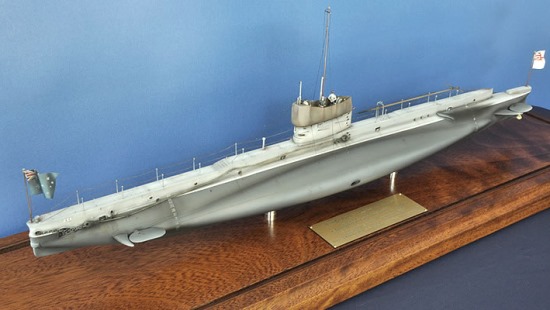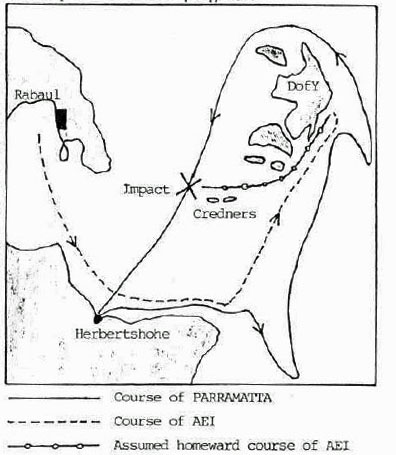The loss of submarine AE1 in 1914
Ken Humphreys
The loss of submarine AE1 in 1914
|
Members may recall the disappearance of RAN Submarine AE1 in German New Guinea on 14 September 1914. AE1 vanished whilst on a patrol with destroyer HMAS Parramatta north-east of Cape Gazelle. No oil slick, body or debris was ever seen, even with the search being continued to February 1915. There have been searches since by Naval and private vessels but with no result. Accordingly l was surprised to read in The Neglected War by HJ Hiery (p 275, Note 68) that: “According to statements by the crew of torpedo boat Parramatta, it collided with the submarine and pulled it down: UPNG AL-101/l Reminiscences of J.R. Fox." Luckily a PNG resident made the effort and accessed the box of papers in the Michael Somare Library for me. Access is not restricted, but photocopying is forbidden. The box contains maps, passports, a telescope and compass used by Fox on a prospecting trek from Mt Hagen to Dutch New Guinea in 1934. Now who was this Fox who had a long association with New Guinea? John Raven and Thomas Alsten Fox were twins. They arrived from England on 3 August 1914 apparently on the P&O Cape Route Berrima which was to be chartered by the Defence Department to transport an expeditionary force to silence the new wireless station at Bitapaka in New Guinea. The brothers promptly enlisted at Sydney Victoria Barracks on 11 August and were assigned to A Company in the Australian Naval & Military Expeditionary Force. However the brothers, and many others we presume, thought they were sailing for France! John Fox then served in Rabaul and had contact with crew of the Parramatta. Fox's reminiscences include this comment, possibly written in the 1960s when Fox was around seventy: "Parramatta crew said they struck something pretty solid on going out on patrol at dusk with lights showing. They were going by the Bee Hives when it collided with something presumed a big log or small raft. They didn’t stop as there was a war on and no lights allowed and the German fleet was still around a lot of sailors believe the A1l is on the bottom around 60 fathoms deep near the Bee Hives." (Copied as written: in biro) Fox was incorrect in a number of observations; understandable, as he was writing of an event that occurred fifty years previously and which was enveloped with hearsay and scuttlebutt. A reconstruction of the disaster has the AE1 leaving Simpsonhafen in early morning, while the Parramatta raised her anchor at Herbertshohe. The Parramatta was never near the Bee Hives during that day. The two vessels rendezvoused off Cape Gazelle at 0900. AE1 went north-east and the destroyer patrolled south until lunch then reversed course toward the Duke of York Group. Visual contact with AE1 was then maintained from 1430 to 1520, AE1 being five miles north-east of Parramatta and two miles off Point Berard when last seen. There was heavy low haze, due to bush fires or natives hunting game with fire. New Guinea was experiencing drought at the time. Both vessels had been ordered to return at dusk to their anchorages: around 1800 hours. I assume AE1 had to return to Simpsonhafen to tie up to her mother ship HMAS Protector. After Parramatta lost sight of AE1 at 1520, her captain decided that the submarine was heading home on a course which would pass the Credner Islands on her port. Parramatta then went home around the north of the Duke of Yorks and anchored at Herbertshohe at 19.00. Not long after, the alarm was raised and a search begun. One odd fact is that there was an absolute minimum of Morse traffic between the two vessels. One would think that Parramatta would have advised AE1 she was going home around the Duke of Yorks. Having to code/decode transmissions would take time, so no Captain wanted to complicate a patrol that really was just keeping the crews occupied. There have been many theories on what happened to AE1. The following is also speculation but the concept of a collision was not previously entertained. As a general rule submarines cannot dive very much deeper than their own length. AE1's length was equal to 30 fathoms, so in theory, her absolute maximum operating depth was 40 fathoms with a hull collapse depth of 60 fathoms. Thus the submarine is now sited as far down as 50 fathoms. A depth approaching 60 fathoms would have produced egress of debris and fuel. Fuel capacity was 42 tons of Abadan diesel, enough for 3,000 miles of surface running at l0 knots. There were two submarines in New Guinea, AE1 and AE2 and they alone used diesel. The destroyers bunt fuel oil and the cruisers burnt a mixture of coal and fuel oil, For example, the battle cruiser HMAS Australia had to burn a mix of one ton fuel oil to two tons coal when using the poor quality Port Kembla product. Welsh coal was the most efficient burner closely followed by the New Zealand Westport coal. I would suggest AE1 was carrying 35 tons of diesel when lost, taken from the Shell bulk carrier Murex which had accompanied the fleet to Rabaul. There were no fuel oil or diesel refueling facilities in Rabaul, only coal was available. And those stocks were minimal as local shipping and the mail boats had devoured supplies as the European situation worsened. Interesting to note that the six cylinder Daimler engines in the first British tanks used 80/87 aviation fuel with a consumption of two miles per gallon! They were probably more interested in locating the carbide lights of Herbertshohe. But the watch on the AE1 bridge could see the darkened Parramatta against the fading light so told the control room to DIVE DIVE DIVE as it was too late to turn right full rudder using the steering atop the conning tower. They cleared the tower and closed the hatch. But AE1 was in no shape to dive irrespective of any fleet order. She had not dived in the morning possibly because the starboard diesel was needing repair, thus battery potential was insufficient. And it was not practice to dive at the end of the day when retuning to base. lt is possible that the two submarines had been forbidden to dive in New Guinea as there is good evidence they were using German charts. That posed a problem, in that on German charts the symbol for the 6 metre (3 fathoms) line with deep water close up to it is the same as that used on Admiralty charts to denote a hard edge drying reef. The drying reef on German charts is indicated by the same symbol as the 3 fathom line, but is covered with a network of fine straight lines. Thus the AE1 navigator could think that a reef was 3 fathom water. The E Class draught was I3 feet. So AE1 was on the surface. What immediately happened was that the Parramatta crashed over the bow or the stern of AE1. Most probably the bow, as damage to the stern would allow lubricating oil and diesel to escape. We assume AE1 was carrying torpedoes but they would not have been fitted with warheads. Water gushed into the bow and crew may have been able to close a forward bulkhead door thus completely sealing up the submarine forever. AE1 then sank by the bow and chlorine gas killed the men. Around 50 fathoms she jammed into the northern substratum of the Credner Islands and there she remains, sealed and immune to detection. As she carried 35 tons of diesel and 17 tons of electrolyte in the 224 battery cells, some evidence of her position would still be seeping out if she was not completely sealed at 50 fathoms. The sea bottom around the Credners lies at 200 fathoms. So if AE1 free fell after the collision, she would have imploded around 60-70 fathoms. The wreck would fall to the sea floor but the crew and tons of fuel and debris would come to the surface and be visible for many days, irrespective of currents. To deepen the mystery of AE1's location, it so happens that both Credners are popular diving sites. To the north of the western island is the Little Pigeon and Malis site. To the east is Rebecca's Corner. In theory the maximum dive depth is 20 fathoms with 25 fathoms lateral visibility. But that does not mean that down at 20 fathoms, a diver‘s visibility would reach to 45 fathoms, just short of where AE1 is. One assumes that both sites have been dived for around twenty-five years. Yet not one drop of diesel has been seen. lt makes one think that AE1 went home on a course south of the Credners. This article finishes with a postscript on the Fox brothers. James Sinclair in Wings of Gold has the duo retuning to New Guinea in 1922 and describes their 1934 prospecting trek to “the foot of the rainbow" in Chapter 31. Other information is that both men successfully tendered for expropriated German plantations. They again came back after 1945 and managed plantations at Aiyura and Mt Hagen. References: "Australia's First Submarine", Article by P.J. Richardson in Air Niugini Journal Paradise, No. 119, Jan-Feb 1997. Australian Submarines - A history, M.W.D. White, Australian Government Publishing Service, Canberra, 1992. Official History of Australia in the 1914-18 War, Volumes IX and X. Straws in the Wind, Cdr H.G. Stoker RN, Herbert Jenkins, London, 1925. "The Loss of AE1 on 14 September 1914", Article by M.W.D. White, Journal of the Royal Historical Society of Qld, Vol. Xll, No. 5, Aug 1986. The Neglected War, H.J. Hicry, University of Hawaii Press, 1995. The Dive Sites of PNG, R. Halstead, New Holland Publishers, Sydney, 1996. "Tom Besant, Where Are You?" Cdr JD. Foster RAN, Defence Force Journal No. 5, July/Aug, 1977. Wings of Gold, J. Sinclair, Robert Brown & Associates, 1983. Further information: There is detailed information about the construction, crew and loss of AE1 at www.ae1submarine.com There is also information on the submarine, and the present sdearch for its wreckage at www.ae1.org.au
|

 With dusk at 1800
hours and thick haze, AE1 was
heading west into the fading
light so had some ability in
discerning silhouettes. The Parramatta was heading
south-west and could see
topography to starboard but
not to port. Thus her port
lookouts could not see the low profile AE1 approaching on a
possible collision course.
With dusk at 1800
hours and thick haze, AE1 was
heading west into the fading
light so had some ability in
discerning silhouettes. The Parramatta was heading
south-west and could see
topography to starboard but
not to port. Thus her port
lookouts could not see the low profile AE1 approaching on a
possible collision course.